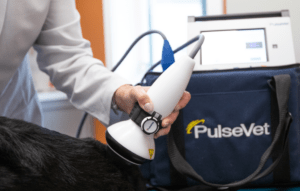Making Waves in Small Animal General Practice
What is Shock Wave Therapy?
When people first hear the term shock wave, they often think of electrical shock, but shock wave is simply a physics term for a supersonic high-energy sound wave that can be used to treat various musculoskeletal indications. Shock waves are applied superficially and cause a biological cascade within the tissue, decreasing inflammation and pain. As a result, patients experience an increase in bone, tendon, and tissue healing.
Shock Wave Generation
There are three basic types of shock wave generators: electrohydraulic, electromagnetic, and piezoelectric. Electrohydraulic devices are by far the most clinically proven to provide results safely and effectively in veterinary medicine. Both electromagnetic and piezoelectric shock wave devices generate a much smaller amount of total energy into a considerably smaller focal area.
How Does Shock Wave Therapy Work?
Shock wave therapy is applied superficially; energy enters the body and is released in the tissues when it meets an area of density change. The cells then release anti-inflammatory, angiogenic, and osteogenic proteins that aid in pain relief, tissue regeneration, and bone healing. Cytokines are released that reinitiate the healing process, angiogenic growth factors are released that increase the functional capillary density to promote healing in soft tissues, and BMP is released to stimulate bone healing.
Cutting-Edge, Sedation Free Shock Wave Technology
In 2021, PulseVet released the X-Trode, a new hand piece that deposits the energy into an even larger focal zone while reducing the intense central peak energy, taking the “sting” out of shock wave treatment. Dogs, and even cats, are now able to be treated without sedation.
Which Canine Indications are Treated with PulseVet Shock Wave?
Tendon/Ligament Injuries: Shock wave therapy has been proven to decrease inflammation and increase fiber alignment in tendon and ligament injuries.
Osteoarthritis and Non-Neurologic Back Pain: Shock wave therapy has been proven to be part of a multi-modal approach to osteoarthritis management. Inflammatory cytokine release is reduced in the joint and cartilage degradation is decreased due to the inhibition of chondrocyte apoptosis.
Chronic Wounds and Lick Granulomas: Shock wave therapy is now approved for treatment of diabetic ulcers in humans. In canine patients, shockwave has been used effectively to resolve lick granulomas after only 1-3 weekly treatments.
Bone Healing: Shock wave therapy has been shown to accelerate healing of fractures and osteotomies in clinical studies and is particularly effective for use in delayed union or trophic nonunion fractures.
Why Should I Offer Shock Wave Therapy?
Pet owners are often seeking non-invasive and advanced treatments to improve their pet’s quality of life. The ability to offer a clinically proven, safe, and sedation free treatment for difficult cases, such as shoulder injuries, non-healing fractures, lick granulomas, osteoarthritis, and chronic pain, will set your hospital apart. With the new technology of the PulseVet X-Trode that allows for sedation free treatment, shock wave therapy is becoming a staple of small animal veterinary medicine in the future.






